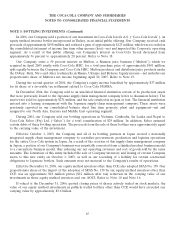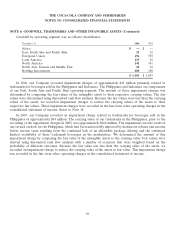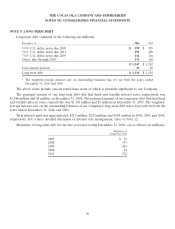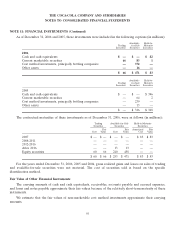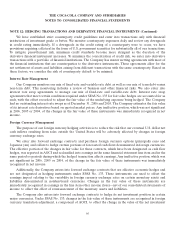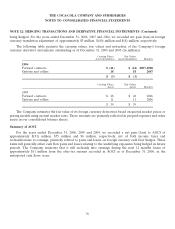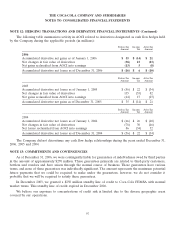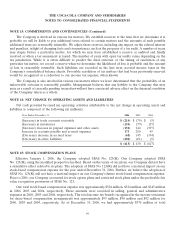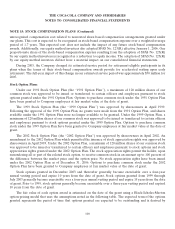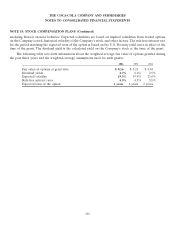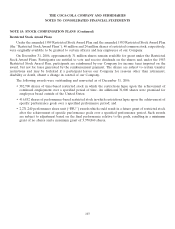Coca Cola 2006 Annual Report Download - page 97
Download and view the complete annual report
Please find page 97 of the 2006 Coca Cola annual report below. You can navigate through the pages in the report by either clicking on the pages listed below, or by using the keyword search tool below to find specific information within the annual report.THE COCA-COLA COMPANY AND SUBSIDIARIES
NOTES TO CONSOLIDATED FINANCIAL STATEMENTS
NOTE 12: HEDGING TRANSACTIONS AND DERIVATIVE FINANCIAL INSTRUMENTS (Continued)
We have established strict counterparty credit guidelines and enter into transactions only with financial
institutions of investment grade or better. We monitor counterparty exposures daily and review any downgrade
in credit rating immediately. If a downgrade in the credit rating of a counterparty were to occur, we have
provisions requiring collateral in the form of U.S. government securities for substantially all of our transactions.
To mitigate presettlement risk, minimum credit standards become more stringent as the duration of the
derivative financial instrument increases. To minimize the concentration of credit risk, we enter into derivative
transactions with a portfolio of financial institutions. The Company has master netting agreements with most of
the financial institutions that are counterparties to the derivative instruments. These agreements allow for the
net settlement of assets and liabilities arising from different transactions with the same counterparty. Based on
these factors, we consider the risk of counterparty default to be minimal.
Interest Rate Management
Our Company monitors our mix of fixed-rate and variable-rate debt as well as our mix of term debt versus
non-term debt. This monitoring includes a review of business and other financial risks. We also enter into
interest rate swap agreements to manage our mix of fixed-rate and variable-rate debt. Interest rate swap
agreements that meet certain conditions required under SFAS No. 133 for fair value hedges are accounted for as
such, with the offset recorded to adjust the fair value of the underlying exposure being hedged. The Company
had no outstanding interest rate swaps as of December 31, 2006 and 2005. The Company estimates the fair value
of its interest rate derivatives based on quoted market prices. Any ineffective portion, which was not significant
in 2006, 2005 or 2004, of the changes in the fair value of these instruments was immediately recognized in net
income.
Foreign Currency Management
The purpose of our foreign currency hedging activities is to reduce the risk that our eventual U.S. dollar net
cash inflows resulting from sales outside the United States will be adversely affected by changes in foreign
currency exchange rates.
We enter into forward exchange contracts and purchase foreign currency options (principally euro and
Japanese yen) and collars to hedge certain portions of forecasted cash flows denominated in foreign currencies.
The effective portion of the changes in fair value for these contracts, which have been designated as cash flow
hedges, was reported in AOCI and reclassified into earnings in the same financial statement line item and in the
same period or periods during which the hedged transaction affects earnings. Any ineffective portion, which was
not significant in 2006, 2005 or 2004, of the change in the fair value of these instruments was immediately
recognized in net income.
Additionally, the Company enters into forward exchange contracts that are effective economic hedges and
are not designated as hedging instruments under SFAS No. 133. These instruments are used to offset the
earnings impact relating to the variability in foreign currency exchange rates on certain monetary assets and
liabilities denominated in nonfunctional currencies. Changes in the fair value of these instruments are
immediately recognized in earnings in the line item other income (loss)—net of our consolidated statements of
income to offset the effect of remeasurement of the monetary assets and liabilities.
The Company also enters into forward exchange contracts to hedge its net investment position in certain
major currencies. Under SFAS No. 133, changes in the fair value of these instruments are recognized in foreign
currency translation adjustment, a component of AOCI, to offset the change in the value of the net investment
95


